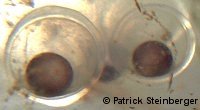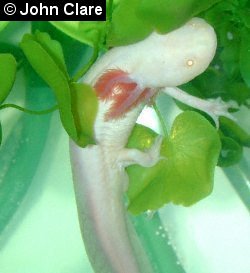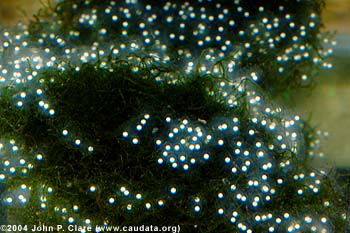| Home | Housing | Feeding | Requirements | Breeding | Biology | Books & Links |

Breeding AxolotlsBefore reading this page, you may find it helpful to first read the Biology Page and the Genetics Page. Basics Axolotls can reach sexual maturity anywhere between 5 months and several years, depending on frequency and quality of food, and the water temperature and conditions in which the animals are kept. My personal record for a fully mature male is just under 6 months (at 25 cm or 10 inches). Axolotls generally begin to mature once they have reached about 18 cm (7 inches) in total length. Females tend to take a little longer to mature than males (usually a difference of a month or two). The Biology Page has a great deal of information about sexing axolotls and their sexual maturity. It is advisable that you don't attemt to breed axolotls until they reach at least 18 months of age. This gives them time to reach their full size (greater than 30 cm or 12 inches in many cases) and condition (a female ready to breed will be very round towards the end of the body when viewed from above). In my opinion it is safe to breed males at an earlier stage than females, because they have much less physical output during the mating process than females, and therefore there is less strain on their bodies. However, females should be prevented from breeding until they reach their full size. There is a very good reason for not breeding your female axolotl(s) too early. A female axolotl can lay in excess of 1000 eggs. Producing so many eggs is a strain on the animal's metabolism, and the body prioritises production of eggs over body growth while the animal is in conditions suitable for breeding. Since females may breed several times each year, as soon as the first batch of eggs are laid, the body attempts to produce new eggs to replace those that have been laid. Female axolotls may fall ill at this point unless due care is taken, and for a female that is still growing in length, the strain is increased. For the same reason, females that have recently bred should be kept away from males for at least a month, preferably two or three, in order for them to recover. From personal experience, I know that just because an axolotl breeds, it doesn't mean it is in good overall health. Breeding methodsMost sources state that the breeding season for axolotls is from December to June. However, they can be bred at any time of the year, although most success is reported in the early part of the year. The former Indiana University Axolotl Colony used changes in the length of light period to trigger spawning. Males and females are subjected to a decreasing "daylight" period over a few weeks, and then the duration of lighting is steadily increased. They then put a male and a female together and courtship behaviour usually follows. An alternate school (Peter W. Scott and some others) instead recommends a sudden change in temperature to trigger courtship behaviour. Keeping the pair separately for a few weeks at 20-22 °C (68-71 °F) and then transferring them both into a tank with a water temperature at least 5 °C lower frequently triggers courtship behaviour. In fact, Scott recommends 12-14 °C (54-57 °F). My own experience, and that of some others, is that this thermal shock method usually just stimulates the male. In order for this procedure to be successful, the female most be receptive and ready to breed. In my experience, by keeping axolotls in a room that receives at least partial seasonal change in temperature and light period (if there is a window in the room), breeding will occur naturally, usually at least once before the peak of winter and once in the spring, if the animals are adequately fed. As mentioned briefly above, exposure to natural day length throughout the year by having the tank in a room that receives natural light is a good idea because light seems to have at least as an important role as temperature in simulating the seasons. A pair of axolotls kept in good conditions should breed at least once a year, albeit unpredictably. Axolotls may spawn for no obvious reason, at "odd" times of the year, as mine have done in the past. Axolotls may surprise you. My Breeding Setup The breeding setup that I use routinely is furnished with many plants (plastic plants are good because they don't rot, but I also use clumps of live Java Moss, Vesicularia dubyana). The plants are for the female axolotl to affix her eggs (pictured on the right is a female melanoid albino in the process of laying its eggs on plastic plant leaves). Slates or flat, rough pieces of stone should be placed on the bottom of the tank for the male to deposit its spermatophores. Spermatophores are packets of sperm - you can read more on these in the courtship and spawning section. Spermatophores will not readily stick to bare glass or plastic, so in order for mating to be successful the spermatophore must be stationary during courtship. It is usually a good idea to put the tank in a room where it will be left alone, so as not to disturb the pair. Courtship and Spawning Spawning is initiated by the male, who swims around, raising its tail and making vigorous writhing motions. The male nudges the female's vent occasionally and then leads her around the tank. The spermatophore is a common "device" in the salamander and newt world (an old one, about 12 hours old, is pictured beside this paragraph). It is a packet of sperm attached to the top of a cone of jelly. The male deposits between 5 and 25 of these around the tank and attempts to lead the female over them. She picks up the sperm cap (from one or more spermatophores) in her cloaca - fertilisation takes place internally. She may also nudge the male's vent, and this can lead to a prolonged "dance" around the tank. Between a few hours and two days later, she commences spawning, laying each egg individually. She will lay them on the leaves of plants, if available, but if not, she will place them about the tank, attaching them to rocks, pipes and any other object available. There may be between 100 and over a thousand eggs laid in one spawning, depending on the size of the female and if she is in optimal condition at spawning. After the female has finished laying, it's best to remove her and the male. Hatching Eggs
Pictured to the right are four 12-hour old eggs. Note the lack of pigment - this indicates that the mother was albino. Normal eggs are dark brown (there is a picture of two at the top of this page). An albino mother will lay white, pigmentless eggs. If the offspring are not albino, pigment will appear during embryo development. The eggs take about 2 to 3 weeks to hatch. Development seems to be optimal when the eggs are attached to plants. This is due to the circulation of water around the egg, aiding gaseous exchange. Assuming the eggs are fertile, the majority of the eggs should hatch if kept in well-aerated water. An air pump and air stone at one end of the tank will be helpful, just be sure it doesn't cause vigorous water flow. At 20 °C (68 °F) the eggs should hatch after about 17 days. Have a look at the Embryo Series Photo Log for a daily photographic account of the development of some white eggs. Now, have a look at the page about Rearing young axolotls, which includes photos of a small sample setup. Unless cited in the Acknowledgements, all text and images are ©1998-2019 John P. Clare. All Rights Reserved. Bookmark Axolotl.org with:
What are these? | ||||||







 reddit
reddit Facebook
Facebook